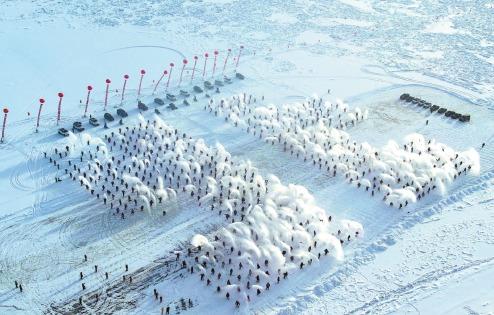 Hundreds of residents and tourists in Heilongjiang province join a traditional activity of tossing hot water from pots into the freezing air, creating a spectacular scene as the water instantly freezes to form icy arcs and spiky "clouds", at the opening ceremonies of the first Polar Forest Ice Carnival and the 13th Winter Solstice Cultural Festival in the province's Beiji village, Mohe city, on Dec 18, 2022. (SHAO TIANLI / FOR CHINA DAILY)
Hundreds of residents and tourists in Heilongjiang province join a traditional activity of tossing hot water from pots into the freezing air, creating a spectacular scene as the water instantly freezes to form icy arcs and spiky "clouds", at the opening ceremonies of the first Polar Forest Ice Carnival and the 13th Winter Solstice Cultural Festival in the province's Beiji village, Mohe city, on Dec 18, 2022. (SHAO TIANLI / FOR CHINA DAILY)
The New Year arrives in Northeast China with really cold days and nights, but it's also peak season for winter tourism of both conventional and unconventional sorts.
In this season, the provinces of Jilin and Heilongjiang, for instance, are working hard to expand activities in the wonderlands of ice and snow, where conventional activities include skiing and unconventional ones include art extravaganzas, featuring ice sculptures.
The 2022 Winter Olympics were held in Beijing and nearby Hebei province, also in the country's north, in early 2022.
In the region, Jilin has kept its focus on building a snow-and-ice industrial system combining tourism, sports, culture and equipment manufacturing. The construction of "ice-and-snow sports towns" and ski resorts of large and medium sizes also continues, with the aim of attracting more tourists to the province to experience winter fun, according to the local government.
Over the past five years, the province has developed an ice-and-snow industry in "Jilin style" and seen achievements in innovation, policy guidance, "breakthrough ideas", cultural confidence and the cultivation of talent, said Mu Dapeng, director of the provincial sports bureau.
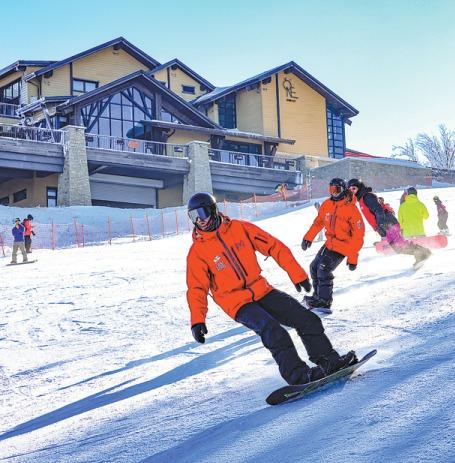 Skiers enjoy the snow at Lake Songhua Resort in Jilin city, Jilin. (SI NUO / FOR CHINA DAILY)
Skiers enjoy the snow at Lake Songhua Resort in Jilin city, Jilin. (SI NUO / FOR CHINA DAILY)
"During the 14th Five-Year Plan period (2021-25), Jilin will give prominence to building a 'new highland' for the innovation and development of the ice-and-snow industry in China."
According to a provincial development plan, by 2025, the monetary size of its ice-and-snow industry is expected to reach 250 billion yuan ($35.8 billion). The province will aim to complete the construction of 100 ski resorts and a large ice-and-snow sports resort as one of the major areas that can engage 300 million people in winter sports in the country.
Now, the province has some 75 ski resorts, with a total of 319 ski slopes, which can handle up to 100,000 people a day, making Jilin the skiing hub of the country. Data from the provincial culture and tourism department showed that during the 2021-2022 snow season, the online sale of ice-and-snow products in Jilin was the most in China.
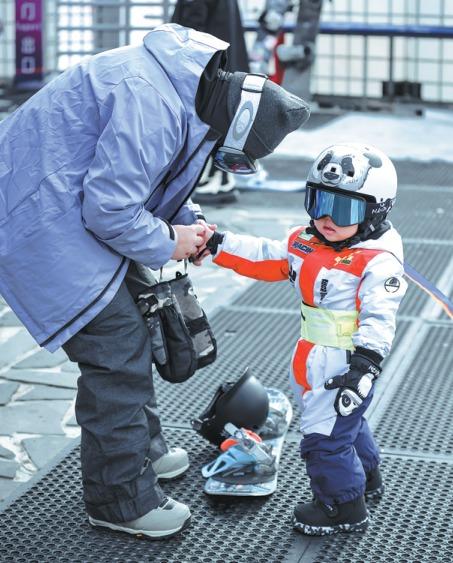 A father helps his child put on gloves before skiing at Miaoxiang Mountain Ski Resort in Changchun, Jilin. (ZHANG JIADONG / FOR CHINA DAILY)
A father helps his child put on gloves before skiing at Miaoxiang Mountain Ski Resort in Changchun, Jilin. (ZHANG JIADONG / FOR CHINA DAILY)
Night skiing
From early November, ski lodges in the province began to open doors to skiers, snowboarders and other winter sports enthusiasts.
Jilin has the largest ski resorts in China, including Lake Songhua Resort, Beidahu Ski Resort and Wanda White Mountain Resort.
Zhang Yibing, 60, an enthusiastic snowboarder from Changchun, the provincial capital, has become a "big star" among skiers at the Lake Songhua Resort in Jilin city since it opened in January 2015.
"I began to ski in 2002 and have been enchanted with snowboarding for 17 years," he said. "It's a great thrill for a snowboarder like me to enjoy the resort where the infrastructure has been built at an international level."
He spends most of his spare time in winter at the resort, especially after his workload began to reduce due to age in recent years.
"Traveling from Changchun is convenient," he said. "I spend only one and a half hours driving or 40 minutes by high-speed railway."
"Jilin province has some of the country's best resources and favorable temperatures for winter sports," he added. "For those who come from the south, frequent flights and high-speed trains can make their trips easier."
Since the opening of the new winter season in Changchun, 44-year-old photographer Zhang Jiadong spends much of his spare time taking photos for skiers at the city's Miaoxiang Mountain Ski Resort to record their special moments.
"I found that a lot of enthusiasts like to ski in the evenings," he said. "It has become fashionable among office workers."
For the new season, lighting systems to illuminate the slopes have been renovated, said Zhang Yinan, a staff member at the resort.
Night skiing is open from 5:30 pm to 9 pm, attracting many office workers.
Zhang Jiadong said he also found that more children are taking to winter sports.
"The 2022 Winter Olympics have aroused public interest in winter sports in the country," he said. "Skiing has become an essential skill for many people to acquire."
The annual skiing season lasts for about 150 days in Jilin and a series of activities during the period is expected to boost development of the ice-and-snow economy in the region, according to local officials.
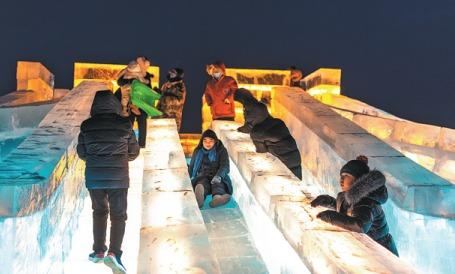 Tourists on top of a 500-meter ice slide at the 24th Harbin Ice and Snow World in Harbin, Heilongjiang province, which opened in December, 2022. (PHOTO / CHINA DAILY)
Tourists on top of a 500-meter ice slide at the 24th Harbin Ice and Snow World in Harbin, Heilongjiang province, which opened in December, 2022. (PHOTO / CHINA DAILY)
Ice festival
Neighboring Heilongjiang province is also working out its plan for winter tourism.
For this winter season, the provincial culture and tourism department has launched major themed tourism products such as viewing winter scenery and experiencing related cultural activities across some 148 tourist spots. There are some 65 experience-themed destinations where tourists can enjoy the province's winter scenery.
After years of development of winter tourism routes and products, the provincial capital Harbin, also known as "ice city", has formed a relatively mature system and become a popular choice for tourists.
Residents and tourists in Harbin can easily find wintertime experiences through its ice-and-snow sculptures and entertainment offerings.
The 24th Harbin Ice and Snow World opened on Dec 17, welcoming the first visitors to the winter wonderland in Harbin. As an important part of the city's winter tourism season, the park has seasonally opened for 23 consecutive years.
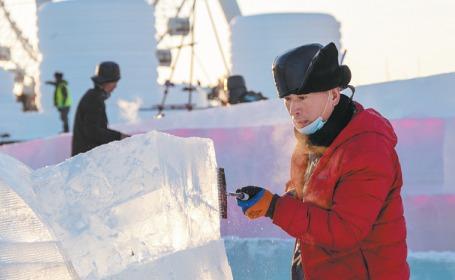 Workers process ice blocks for the 24th Harbin Ice and Snow World. (PHOTO / CHINA DAILY)
Workers process ice blocks for the 24th Harbin Ice and Snow World. (PHOTO / CHINA DAILY)
Across the 810,000-square-meter amusement park, which combines ice, snow, and sound and lights, visitors can appreciate more than 100 groups of artworks made with ice rather than commonly used construction materials.
As people-made ice often contains air bubbles and is not strong enough to carve, ice for the festival is initially gathered from Songhua River, which runs through the city.
Under the rules, each block of ice must be 80 centimeters wide, 40 cm thick and 120 cm long.
After the first block of ice was pulled from the frozen river in early December, as much as 150,000 cubic meters of ice was transformed into fanciful buildings and sculptures, turning the park into an icy wonderland.
Tourists can participate in many activities, including riding on a 500-meter ice slide, the longest at the park to date.
A Ferris wheel in the shape of a giant snowflake has been built to provide a thrilling experience in a dazzling world after dark.
"Due to our concern about health safety on a long journey, I have suspended my family's annual travel plans," said local resident Zhou Xuan. "But as the most famous tourist spot in the city, my husband and I brought our 10-year-old son for a visit here."
"We are all surprised to find such a spectacular landscape even though we are so familiar with ice and snow," she added.
Another important event in the city — the 35th China Harbin Sun Island International Snow Sculpture Art Expo — kicked off on Dec 22, following three weeks of preparation.
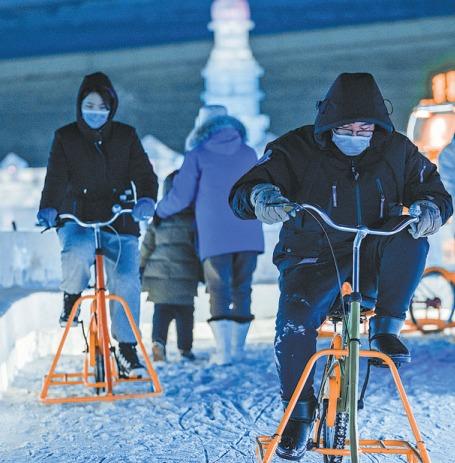 Tourists cycle on ice at the 24th Harbin Ice and Snow World. (PHOTO / CHINA DAILY)
Tourists cycle on ice at the 24th Harbin Ice and Snow World. (PHOTO / CHINA DAILY)
At the expo, which is held at Sun Island Park, tourists can view 160 sets of snow sculptures that use more than 150,000 cubic meters of snow, including the 100-meter-long main sculpture, "Chasing a dream", which was completed in 10 days by 70 sculptors. It is based on the "flying maidens" of Buddhist art in Dunhuang, Gansu province, and combines aerospace elements to express the vision of the whole country toward a happy future.
Several snow sculpture competitions will be held at the park during the expo, which will last through February.
Northernmost city
Despite temperatures in Mohe dropping to minus 40 C, China's northernmost city is presenting its winter charm to tourists.
The city is one of the few places in China with a subarctic climate — long, severe winters and short, warm summers. Winter begins in early to mid-October and lasts until late April. It is the coldest place in China, holding the record for the lowest temperature at minus 52.3 C in 1956.
Beiji village, 88 kilometers from the city center, virtually attracts all visitors to Mohe, to see China's northernmost bank and post office, as well as to experience traditional rural life in the country's northeast.
The first Polar Forest Ice Carnival and the 13th Winter Solstice Cultural Festival kicked off on Dec 18 in Beiji, attracting thousands of residents and tourists to join various local folk activities related to ice and snow.
At the opening ceremony, hundreds joined a traditional activity of tossing hot water from pots into the freezing air, creating a spectacular scene as the water instantly froze into icy arcs and spiky "clouds".
"With a variety of winter activities, more residents are attracted to the festival," said local resident Wang Jianlong, adding that it brings people close to nature, too. "Our interest in ice and snow has given new life to the beautiful scenery in Mohe, stirring up winter in the border area."
Zhou Lin, a travel researcher with the Heilongjiang Academy of Social Sciences, said: "Winter tourism in China is producing a new consumption trend. However, it is important to promote consumer experience rather than just trying to expand the market."
Product managers should pay attention to innovation in winter tourism to suit various consumers and improve services, she added.
Contact the writers at zhouhuiying@chinadaily.com.cn


